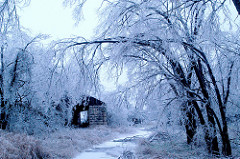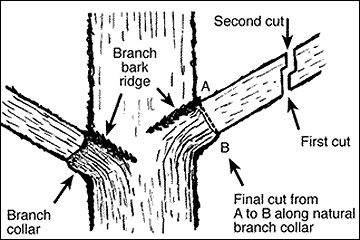Pruning Ice Damaged Trees

What a weather switch from the warmer temperatures we enjoyed over the holidays to this past weekend and the upcoming week. Winter has arrived, with it came some icy precipitation and cold temperatures. Unfortunately, the meteorologists were correct with our weather forecast, and there is another chance of snow coming up later this week.
With the icy weather comes the chance that your trees may have suffered damage over the weekend. Before you do anything outside or work with the trees, you must look for power lines above your head or that could be impacted by the trees you will be working with. I would also look for dangling limbs that could fall on you while you are working. Safety is essential when working with any tree. Don't venture under the tree until it is safe. If large limbs hang precariously, a certified arborist has the tools, training, and knowledge to do the work safely. I also recommend picking up any limbs that have already fallen before starting to prune branches from the tree. Removing those branches makes it easier to move around the yard and reduces the objects you might trip over when you are working.
After that, a careful examination of the tree is necessary to decide if saving the tree is feasible. Below is a checklist of steps to make that decision and give surviving trees the best chance to thrive:
- Decide whether you can save the tree. If the bark on the trunk has been split so the cambium is exposed or the main trunk split open, the tree probably will not survive and should be removed. If there are so many broken limbs that the tree’s form is destroyed, replacement is the best option. Topping, where all the main branches are cut and only stubs are left, is not a recommended pruning procedure. Though new branches usually arise from the stubs, they are not as firmly attached as the original branches and are more likely to break in subsequent storms. Also, the tree must use a lot of energy to develop new branches, leaving less to fight off diseases and insect attacks. Often, the tree's life is shortened.
- Prune broken branches to the next larger branch or the trunk. It’s best to wait until the ice is off the
 trees before pruning because pruning frozen wood can cause more damage than waiting for warmer weather. When cutting the branch back to the trunk, do not cut flush with the trunk, but instead at the collar area between the branch and the trunk. (See the photo to the right) Cutting flush with the trunk leaves a much larger wound than cutting at the collar and takes longer to heal. Middle-aged or younger, vigorous trees can have up to one-third of the crown removed and still make a surprisingly swift comeback.
trees before pruning because pruning frozen wood can cause more damage than waiting for warmer weather. When cutting the branch back to the trunk, do not cut flush with the trunk, but instead at the collar area between the branch and the trunk. (See the photo to the right) Cutting flush with the trunk leaves a much larger wound than cutting at the collar and takes longer to heal. Middle-aged or younger, vigorous trees can have up to one-third of the crown removed and still make a surprisingly swift comeback. - Take large limbs off in stages. If you try to remove a large limb in one cut, it will often break before the cut is finished and strip bark from the tree. Instead, first, cut about 15 inches from the trunk. Start from the bottom and cut one-third up through the limb. Make the second cut from the top down, but start 2 inches further away from the trunk than the first. The branch will break away as you make the second cut. The third cut, made at the collar area, removes the left stub.
I’m grateful this ice storm didn’t end up being as bad as storms in the past. Hopefully, this checklist isn’t needed in your yard, but if it is, I would guess you might need it.

Have questions? Contact our office where our Horticulture Extension Agent will assist you with questions.
Phone: (316) 321-9660
Email: callae@ksu.edu